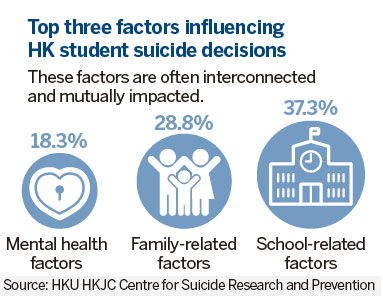Rising teen suicides demands urgent, proactive response
The child suicide rate is low but increasing. It should be zero. The tragedy of loss is real. Schoolchildren coped with the COVID lockdown. Catch-up pressure combined with fractured families adds to the stress. Should the education system embrace holistic well-being to prevent teen suicide? Oasis Hu


Community effort
Wai of the Samaritan Befrienders says recognizing potential suicide signs should not be limited to professionals. Parents, teachers, and classmates can all play a role, but society must first offer them the required emotional education, coaching, and mental health awareness.
Students may exhibit abnormalities in physical, behavioral, emotional, and mental aspects, notes Wai. For example, physically, they may suffer headaches, insomnia, or stomach pain. Behaviorally, there may be a sudden decline in grades or a reluctance to socialize. Emotionally, they may exhibit depression and sadness. Mentally, they may harbor negative thoughts.
When noticing these signs, parents, teachers, and friends must prioritize the emotional well-being of students. When students consistently fail to complete homework, a teacher might investigate emotional stress, instead of readily disciplining the pupil, suggests Wai.
Christian Services' Chung calls for society to combat the stigmatization of mental health issues and eliminate the shame around help-seeking, empowering youth to openly discuss distress without fear of judgment. Also, since students often confide their problems only to those to whom they are closest and whom they trust, society must foster closer relationships and connections within communities and schools.
- Chang'e 6 samples show moon's asymmetry
- Vice-premier calls for more efficient policy implementation
- Top political adviser urges sustained pairing assistance to Xinjiang
- Top legislator stresses high-quality legislative work
- Global representatives hail Shanghai's achievements
- National health body bans use of LVA surgery to treat Alzheimer's





































